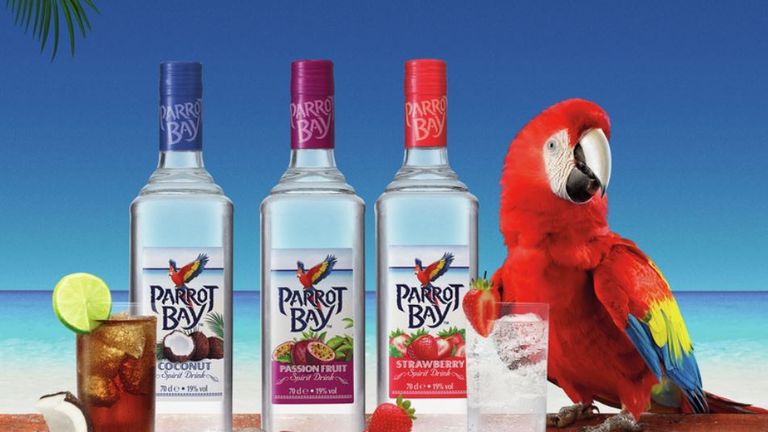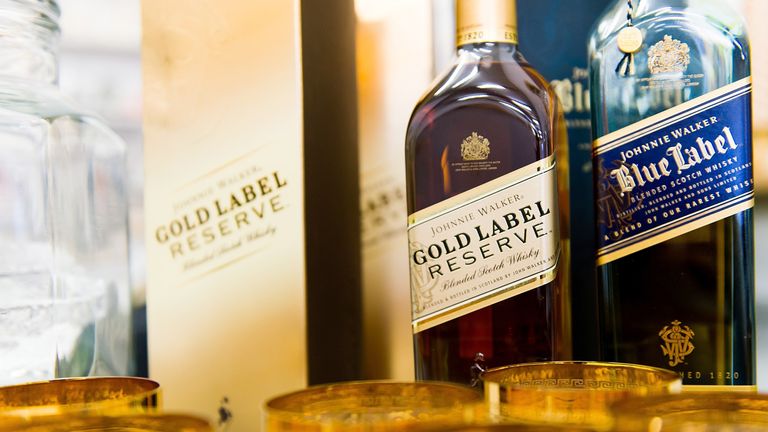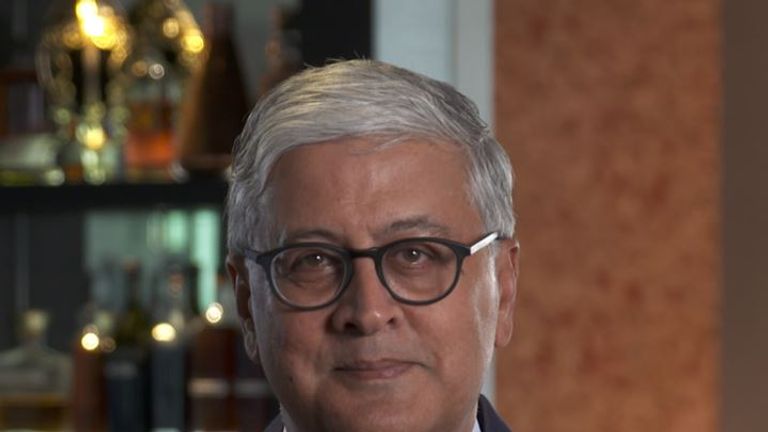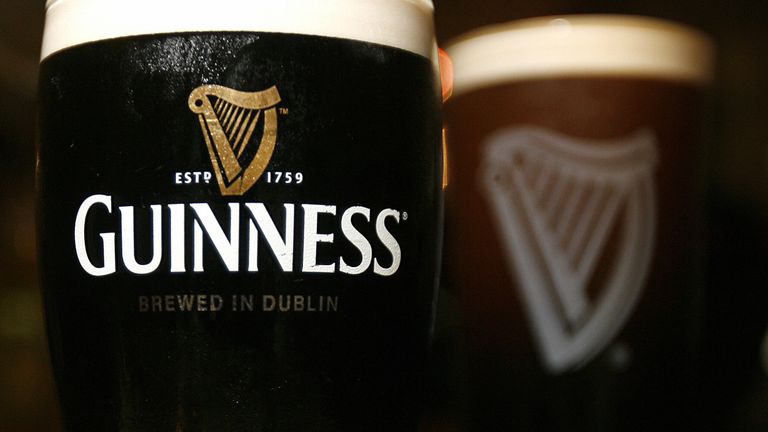Diageo completes $550m spirits sale in 'premiumisation' drive
Sky's Ian King explains the rationale behind the drinks company's decision to sell off 19 spirits brands in a hit to earnings.
Monday 12 November 2018 16:53, UK
It says much about the sheer size and scale of Diageo, the world's biggest spirits company, that many of the brands it has offloaded in a $550m (£427m) sale today are largely unknown in this country.
The best-known of the 19 brands being acquired by US-based Sazerac are probably Seagram's VO and Seagram's Five Star, the Canadian whisky brands.
Other brands being sold include Romana, a Sambuca brand; Myers's, a rum brand; Goldschlager, a schnapps brand; Parrot Bay, a rum-based liqueur; Yukon Jack, a whisky liqueur; Popov, a vodka brand; Scoresby, a blended whisky and the unappealing-sounding Piehole, a Canadian whisky-based liqueur.
The deal follows a six-month sale process first reported by Sky News earlier this year.
It also reveals more about where Ivan Menezes, the Diageo chief executive, wants to take the company.
For this is a sale that, in the short run, is going to be "dilutive", in other words, it will hit Diageo's earnings.
Mr Menezes has sweetened that hit by promising shareholders that the sale proceeds will be returned to them in the form of a share buy-back.
He argues that this is an example of Diageo deciding it can allocate its resources and capital to better use elsewhere and, specifically, to more up-market drink brands.
He added: "The disposal of these brands enables us to have even greater focus on the faster growing premium and above brands in the US spirits portfolio."
So this sale is all about "premiumisation", persuading consumers that as their disposable incomes rise, they can afford to drink more exclusive and up-market products.
This is something in which Diageo has achieved success with Johnnie Walker Blue Label whisky and Ciroc vodka. Many of the brands being sold are relatively niche, such as Black Haus, a blackberry-flavoured schnapps.
The sale is also eye-catching in that it shows Diageo is unafraid of offloading brands it has, in some cases, only owned for a relatively short period of time.
For example, Piehole, a range of pie-flavoured liqueurs based on pie flavours such as apple, pecan and cherry, was only launched as recently as November 2014, but failed to take off.
Likewise Peligroso, itself a super-premium tequila brand, was acquired only in January 2014 but found itself rapidly eclipsed in Diageo's favours when, in June 2017, the company paid George Clooney and his business partners $1bn for Casamigos tequila.
And Stirrings, a cocktail mixers brand, was only acquired in its entirety in June 2009.
And it is a reminder, too, that Mr Menezes is just as happy unloading assets as he is acquiring them.
Since succeeding Paul Walsh as chief executive in 2013, he has sold Bushmills, the Irish whiskey brand; Diageo's wine business, which included Blossom Hill, the UK's second best-selling wine brand; Diageo's stake in Desnoes & Geddes, the Jamaica brewer behind Red Stripe beer and Gleneagles, the luxury Scottish hotel and golf resort.
Ironically, Sazerac, the New Orleans-based company that has bought these brands, has a strategy that is the opposite of Diageo's.
It is owned by Bill Goldring, nicknamed the "cheap liquor billionaire" in the US, who has built the business into America's second-largest spirits company by volume on a strategy of buying cheap brands, marketing them aggressively and selling them on a "pile it high", sell it cheap' basis.
Most of its business is in the US although it has recently acquired a stake in JDL, India's fifth-largest liquor company, while in 2016 it also bought Paddy, the Irish whiskey brand, from Pernod Ricard of France.
It has also bought drinks brands in the past from Diageo itself, such as the bourbon brands WL Weller and Old Charter, while it also has plenty of experience in selling flavoured spirits of the type it is buying in this instance.
This sale also in some ways marks the end of an era for Diageo.
At the beginning of the 1990s, the Montreal-based conglomerate Seagram was the world's second-largest spirits company behind Grand Metropolitan, the group that in 1997 merged with Guinness to form Diageo.
Controlled by the Bronfman family, its brands included Martell cognac, Captain Morgan rum, Chivas Regal and Glenlivet scotch whisky and the eponymous Seagram's Canadian whisky and gin brands, as well as the Mumm and Perrier-Jouet champagne brands. It sponsored the Grand National from 1984 to 1991 under the Seagram brand and then for a further 13 years under the Martell brand.
But in December 2000, it agreed to sell its spirits arm for $8.15bn to Diageo and Pernod Ricard. The Seagram brand itself was split: Seagram's Extra Dry gin, to this day America's best-selling gin, was acquired by Pernod Ricard, with the French company also getting Chivas Regal, Glenlivet, Martell and Glen Grant.
The bulk of the portfolio, though, went to Diageo and, in the process, made it a much bigger player in some drinks categories.
Captain Morgan, in particular, met its need for a top-rank rum brand, even though it was obliged to sell Malibu to appease US competition regulators.
Crown Royal, the Canadian whisky brand, also flourished and today accounts for a significant proportion of Diageo's earnings in the United States. So, too, did the Bulleit bourbon brand.
But several of the brands being sold today also came with that deal, including Myers's, Seagram's VO, Seagram's 83 and Seagram's Five Star.
Significantly, though, the sale does not include the Seagram's Seven Crown American whiskey brand.
With American whiskey proving to be one of the fastest-growing parts of the spirits market for several years, at least part of this 135-year old name looks set to remain in Diageo's drinks cabinet, even if there will now be no fewer than three different companies selling products under the Seagram banner.









